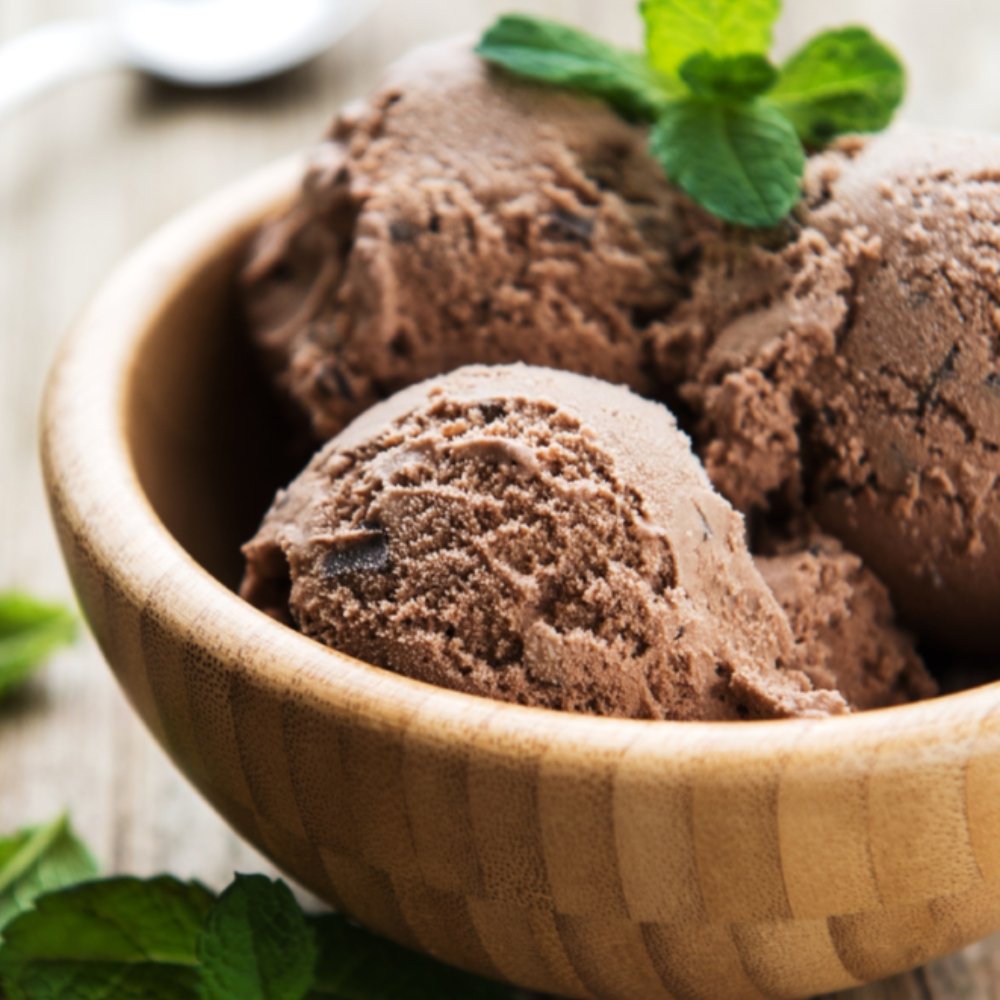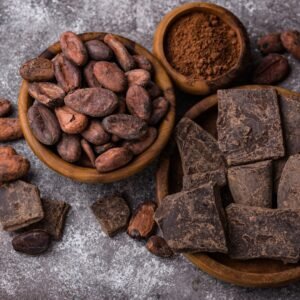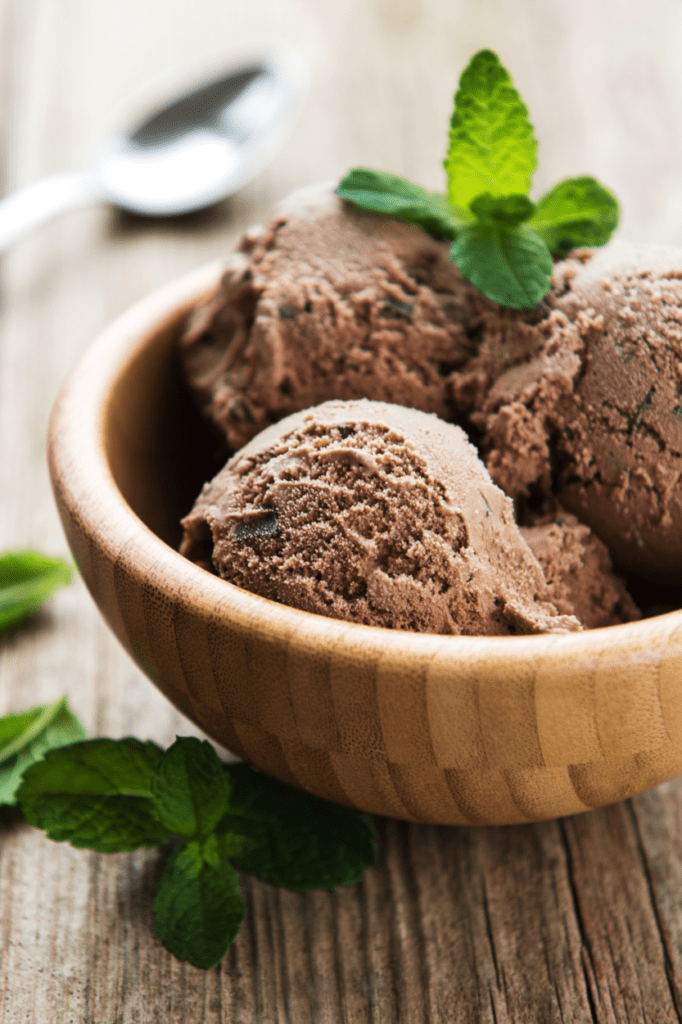KETO LOW-CARB CHOCOLATE ICE CREAM

You’re going to love this Keto Chocolate Ice-Cream recipe. Unsweetened coconut milk is a staple in our household. I use this culinary delicacy in so many ways, including in my caffeine-free Bengal Spice tea. I mix it with yogurt topped with low glycemic fruit (berries), and make from it the most delicious KETO LOW-CARB healthy ice cream on the planet! With its silky texture, natural sweetness, and healthy saturated fat, coconut milk can be easily incorporated into your culinary repertoire and diet.
You can make a whole range of flavored ice cream versions, besides just Keto Chocolate Ice-Cream, such as:
- Mint and Chocolate Chip
- Fresh Vanilla
- Coconut and Lime Sherbet (mix coconut milk with dairy or coconut yogurt)
- Chocolate and Unsweetened Peanut Butter
- Salted Caramel
- Chocolate with Brownies (Use Keto protein bar broken up)
- Adjust your sweetness preference using a natural sweetener like stevia.
WHAT IS THE TASTE PROFILE OF KETO CHOCOLATE ICE- CREAM?
What is the taste profile of Keto Chocolate Coconut Ice Cream? The predominant taste sensation in this ice cream is fattiness and richness and sweetness from the coconut milk and sweetener.
WHAT IS THE NUTRITIONAL VALUE OF KETO CHOCOLATE ICE-CREAM?

What is the nutritional value of Keto Chocolate Coconut Ice Cream? Coconut milk is dairy-free. In fact, it isn’t milk at all. Its heavenly rich liquid comes from inside mature coconuts stored within the “meat.” When cracked open, the coconut’s liquid is watery (coconut water). When this water is blended with the coconut meat and strained, the substance becomes thicker and is referred to as coconut milk.
Younger coconuts are higher in water and contain more natural sugar and certain electrolytes, while mature ones are higher in the ‘meat’, thus higher in healthy saturated fatty acids (from the oil) and calories.
Coconut milk contains beneficial fat called lauric acid, a medium-chain fatty acid easily absorbed and utilized by the body. Lauric acid is antibacterial and antiviral, hence a great ingredient to be consumed in cold and flu season.
Coconuts’ fatty acids are also believed to be “good-for-you” saturated fat that reduces inflammation of the body and brain, improves circulation, and keeps blood vessels flexible and free from plaque buildup. This, in turn, helps to lower cholesterol levels, improve blood pressure, and potentially prevent heart attacks and strokes. Due to its healthy fats, this drupe improves digestion and relieves constipation, thus improving gut health as well.
Its fat content is believed to aid in slowing the rate at which sugar is released into the bloodstream, thereby controlling insulin levels and preventing a sugar high.
Rich and delicious coconut milk makes for the most scrumptious frozen desserts. I absolutely love this refined sugar-free, dairy-free, soy-free, gluten-free ice cream.
WHAT WINE HARMONIZES WITH KETO CHOCOLATE ICE-CREAM?

To create harmony on the palate you would need a non alcoholic wine sweeter than the ice-cream. That’s far too much sugar to consume at one time. Monitoring sugar intake is important because it helps prevent blood sugar spikes and crashes, reduces the risk of health issues like obesity and diabetes, and maintains overall well-being. Choose hot tea. You can always pair the flavours of the crumble with those in the tea. The contrast between the hot tea and ice cold ice-cream will create a delightful texture experience on the palate.
Here are five hot tea options that complement the flavors of chocolate ice cream:
Peppermint Tea: The refreshing and cooling qualities of peppermint tea can provide a delightful contrast to the richness of chocolate ice cream, creating a refreshing pairing.
Rooibos Tea: Rooibos tea has a naturally sweet and nutty flavor that can complement the creamy sweetness of chocolate ice cream without overpowering it.
Masala Chai Tea: The warming spices in masala chai, such as cinnamon, cardamom, and ginger, can enhance the depth of flavor in chocolate ice cream and create a cozy, comforting pairing.
Orange Pekoe Tea: This classic black tea has a robust flavor that can stand up to the richness of chocolate ice cream while providing a smooth and balanced accompaniment.
Jasmine Tea: The floral aroma and delicate flavor of jasmine tea can provide a light and refreshing contrast to the decadence of chocolate ice cream, creating a harmonious pairing that’s perfect for a sophisticated dessert experience.
IS COCONUT MILK KETO FRIENDLY?
Coconut milk is a great option for those following a ketogenic diet. It is low in carbohydrates and high in healthy fats, making it a perfect addition to your keto meal plan. Coconut milk is made from the flesh of mature coconuts, which are high in medium-chain triglycerides (MCTs), a type of healthy fat that can help you stay in ketosis. MCTs are metabolized differently than other types of fats, as they are quickly converted into ketones by the liver, which your body can use for energy. Additionally, coconut milk is a good source of vitamins and minerals, such as potassium, magnesium, and iron. However, it is important to note that some brands of coconut milk may contain added sugars or thickeners, which can increase the carb count. It is best to choose unsweetened coconut milk and check the nutrition label to ensure it fits within your daily carb limit.
HOW DO YOU CHOOSE COCONUT MILK IN KETO CHOCOLATE ICE-CREAM?
Choosing full-fat coconut milk in the grocery store involves checking the product labels and examining the contents of the cans. Here’s a guide on how to do it:
Read the Label:
Look for cans labeled “full-fat” or “whole fat.” These indicate that the product contains a higher percentage of coconut cream, which is the fattier part of coconut milk. Avoid cans labeled “lite” or “light,” as these typically contain a lower percentage of coconut cream and more water.
Check the Ingredients:
Examine the list of ingredients. Full-fat coconut milk should ideally have coconut extract or coconut cream listed as the primary ingredient.
Avoid products with added sugars or preservatives unless you specifically want a sweetened or flavored coconut milk.
Shake the Can:
Give the can a gentle shake. Full-fat coconut milk will have a thicker, creamier consistency, and you may hear less sloshing compared to cans with lower fat content.
Look for Separation:
While on the shelf, you may notice that full-fat coconut milk has a tendency to separate, with the thicker cream rising to the top. This is a good sign that the product is high in fat.
Consider the Brand:
Some brands are known for producing high-quality, full-fat coconut milk. Checking reviews or asking for recommendations can help you choose a reliable brand.
Be Mindful of Additives:
Check for any additives or thickeners in the ingredients. While guar gum and similar additives are common and generally safe, some people prefer coconut milk without these additives.
Look for BPA-Free Cans:
If you are concerned about the lining of the cans, you can choose products that come in BPA-free cans. BPA is a chemical that is sometimes used in the lining of metal cans.
WHY IS RAW ORGANIC CACAO HEALTHIER THAN COCONUT POWDER?

Both raw organic cacao and cocoa powder are derived from the same source, which is the cacao bean, but they undergo different processing methods.
While both can be part of a healthy diet, there are some differences between the two that may influence their perceived health benefits:
Processing Method:
Cacao:
Raw organic cacao is minimally processed and often cold-pressed to retain more of the natural enzymes and nutrients found in the cacao bean. It is typically produced at lower temperatures.
Cocoa:
Cocoa powder is processed at higher temperatures and may go through a more extensive process that includes roasting and alkalizing (dutch processing). This process can reduce the overall nutrient content compared to raw cacao.
Nutrient Content:
Cacao:
Raw cacao is believed to retain a higher concentration of antioxidants, vitamins, and minerals because of its minimal processing. It contains compounds like flavonoids, which have antioxidant properties.
Cocoa:
While cocoa does contain antioxidants, some of them may be diminished during the processing methods. However, it still provides health benefits, and the difference in nutrient content may not be significant for everyone.
Flavor Profile:
Cacao:
Some people prefer the more intense and sometimes bitter flavor of raw cacao. It can have a more complex taste profile compared to cocoa.
Cocoa:
Cocoa is often described as having a milder, smoother flavor. The dutch processing can also reduce bitterness.
Acidity:
Cacao:
Raw cacao tends to be less processed and may have a slightly higher acidity compared to cocoa.
Cocoa:
The dutch processing of cocoa can reduce acidity, making it a preferred option for individuals who are sensitive to acidic foods.
Health Claims:
Some proponents of raw organic cacao argue that the higher nutrient content and minimal processing make it a healthier option. However, scientific research on the health benefits of raw cacao versus cocoa is ongoing, and both can contribute to a nutritious diet.
Personal Preference:
The choice between raw cacao and cocoa often comes down to personal preference in terms of taste and texture. Some recipes may benefit from the intense flavor of raw cacao, while others may be better suited to the milder taste of cocoa.
WHAT KETO LOW-CARB DESSERT RECIPES CAN YOU ENJOY?

KETO LOW-CARB NO-BAKE RASPBERRY CHEESECAKE
Chocolate and PB Cheesecake (Heart Healthy)
No Bake Raspberry Cheesecake (Healthy Heart)
WHAT EQUIPMENT DO YOU NEED TO PREPARE THIS RECIPE?
- Mixing bowl
- Hand mixer or whisk
- Ice cream maker (optional)
- Clean bowl coated in coconut oil (if not using an ice cream maker)
- Plastic wrap or lid for covering
- Freezer
HOW DO YOU PREPARE KETO CHOCOLATE ICE-CREAM?

Add the cocoa powder, powdered erythritol, vanilla extract, and salt to the coconut cream. Using a hand mixer or a whisk, blend the ingredients until well combined and smooth. Taste and adjust sweetness: Taste the mixture and adjust the sweetness according to your preference by adding more sweetener if needed.

Mix until smooth.

Transfer the mixture into a clean bowl coated in coconut oil. (If you like, fold in chopped dark chocolate into the ice cream mixture before freezing for added texture.) Cover bowl with plastic wrap or a lid and freeze for 24 hours, or until the ice cream is firm.

KETO LOW-CARB CHOCOLATE COCONUT MILK ICE CREAM

KETO CHOCOLATE ICE-CREAM
- Total Time: 30
- Yield: 4 1x
- Diet: Gluten Free
Description
Keto Chocolate Ice-Cream uses unsweetened coconut milk, unsweetened coconut powder, erythritol or stevia.
Ingredients
1 can (14 ounces) full-fat coconut milk
1/4 cup unsweetened cocoa powder
1/4 cup powdered erythritol (or any keto-friendly sweetener of your choice)
1/2 teaspoon vanilla extract
1/8 teaspoon salt
Instructions
Optional: 40-50g (about 1.5-2 ounces) 85-90% dark chocolate, chopped (for added texture)
Instructions:
Place the can of coconut milk in the refrigerator for at least 4 hours or overnight. This helps separate the coconut cream from the liquid.
Prepare the ice cream base: Open the chilled can of coconut milk, and carefully scoop out the solid coconut cream into a mixing bowl, leaving behind the liquid. Discard the liquid or save it for other recipes.
In a bowl combine coconut cream with cocoa powder, powdered erythritol, vanilla extract, and salt. Using a hand mixer or a whisk, blend the ingredients until well combined. Mix until smooth.
Taste the mixture and adjust the sweetness according to your preference by adding more sweetener if needed.
Churn the ice cream: If you have an ice cream maker, transfer the mixture to the machine and churn according to the manufacturer’s instructions. If you don’t have an ice cream maker, pour the mixture into a clean bowl coated in coconut oil.
(If you like, fold in chopped dark chocolate into the ice cream mixture before freezing for added texture.)
Cover bowl with plastic wrap or a lid and freeze for 24 hours, or until the ice cream is firm.
When ready to serve, allow the ice cream to soften for a few minutes at room temperature, then scoop and enjoy your delicious keto chocolate ice cream. Add toppings, such as crushed nuts if desired.
Notes
- The values are based on cocoa powder.
- The recipe is based on the keto version and is approximate only. One serving has 1 grams of net carbs.
- (Note: The nutritional information provided is a courtesy and is approximate only. We cannot guarantee the nutritional accuracy of any recipe on this site. We cannot know what brands you use or how accurately you follow the recipe or what you like to add creatively to the dish. Use the information as a general guideline only.)
- Prep Time: 30 mins
- Category: KETO LOW-CARB
- Method: MIXING
- Cuisine: DESSERT
Nutrition
- Serving Size: 1
- Calories: 150
- Sugar: 1
- Sodium: 50
- Fat: 15
- Saturated Fat: 13
- Unsaturated Fat: 2
- Trans Fat: 0
- Carbohydrates: 3
- Fiber: 2
- Protein: 1
- Cholesterol: 0
- UNUSUAL KETO INSTANT POT RECIPES FOR 2025 - April 27, 2025
- Boost Your Keto Diet with These Non-Alcoholic Wine Hacks - April 27, 2025
- 10 Unique & Healthy Mocktails You Need to Try - April 27, 2025


